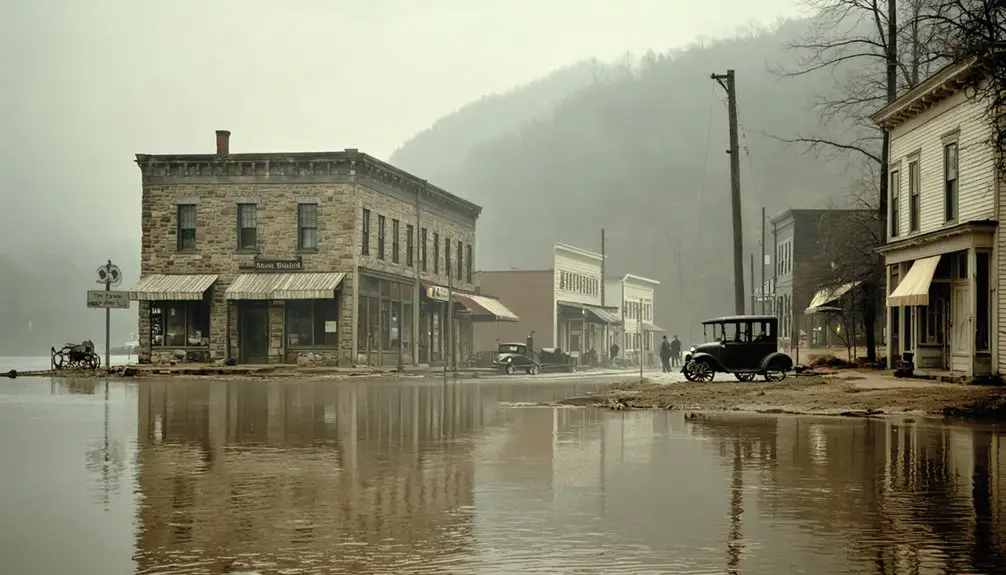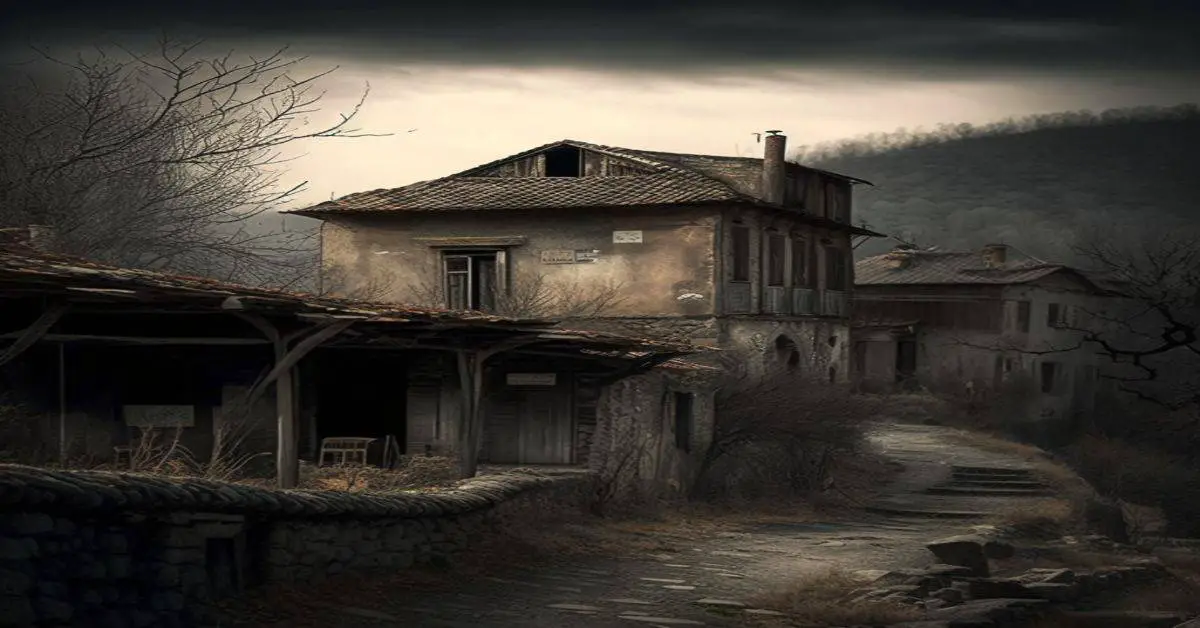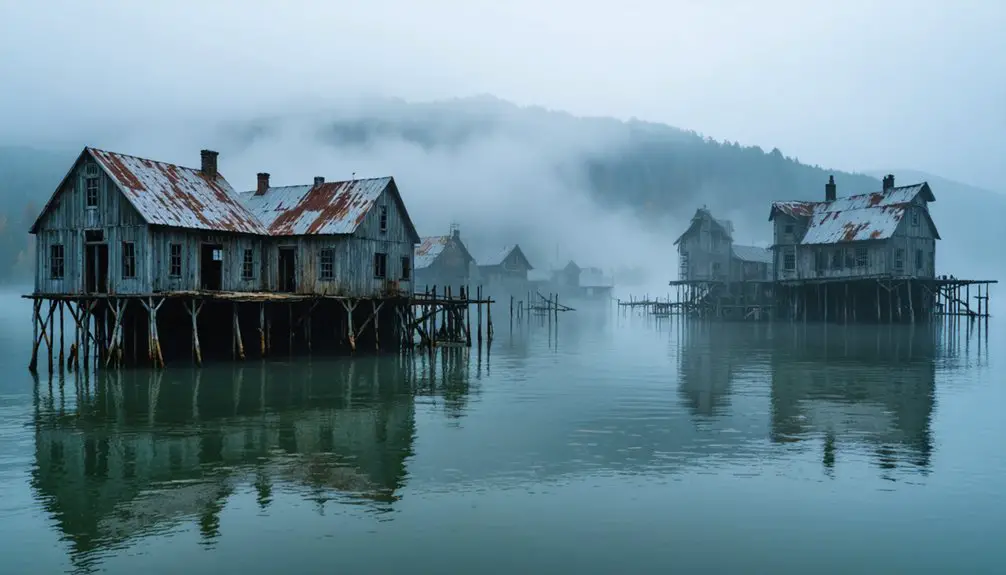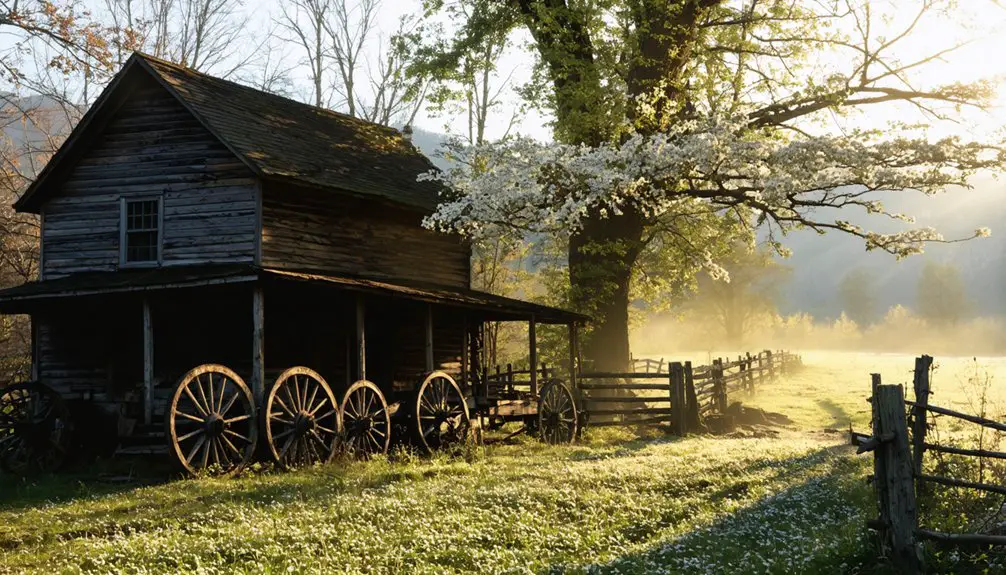You’ll find Old Butler, Tennessee resting beneath the waters of Watauga Lake, submerged by the TVA’s 1948 dam project. This once-thriving riverside town housed 600 residents, with farms, businesses, and the historic Watauga Academy dotting its fertile valley. When the floods came, entire families relocated their homes and even moved 1,281 graves to higher ground. Today’s Butler Museum keeps the town’s spirit alive, preserving stories that run as deep as the lake itself.
Key Takeaways
- Old Butler, Tennessee was submerged underwater in 1948 due to the Tennessee Valley Authority’s construction of Watauga Dam.
- The town contained 650 families and was a thriving farming community before being relocated to create Lake Watauga.
- TVA relocated 600 residents, 125 homes, 50 businesses, and 1,281 graves during the massive relocation project.
- The original town site now lies beneath Lake Watauga, with the Butler Museum preserving artifacts and history from Old Butler.
- Local residents established New Butler along Tennessee State Route 67, creating a new community while preserving their heritage.
The Birth of a Historic River Town
When pioneers first settled along the pristine Watauga River in 1786, they couldn’t have imagined the rich legacy they’d create in what would become Old Butler.
The settlers found themselves in a rare situation where pioneer interactions with Native Americans were largely peaceful, as both groups farmed the fertile valley and shared the land. You can trace the town’s name to the Native American word “Watauga,” meaning “beautiful waters” – a fitting description of the crystalline river that would shape the community’s destiny.
After the Civil War, Old Butler incorporated and flourished into a vibrant river commerce hub. Like the historic role of estate stewards, local leaders managed the town’s resources and directed its growth. By the mid-1940s, the town had grown into a prosperous farming community with 650 families residing there.
The river provided essential transportation routes, connecting the growing settlement to distant markets long before railroads would transform the region’s economic landscape.
Life Along the Watauga Before the Dam
By 1930, you’d have seen nearly 700 residents building their lives around farming, education, and small business.
The town’s cultural heritage blended pioneer and indigenous traditions, creating a unique Appalachian identity.
At Watauga Academy, formerly Holly Spring College, you’d have witnessed up to 200 students pursuing their education.
Life moved at nature’s pace, with the river’s rhythm dictating the seasonal patterns of planting, harvesting, and community gatherings.
The waters that now cover the town flow at 130 cubic feet per second during summer months from TVA releases.
Today, this vibrant community rests beneath the beautiful waters of Watauga Lake, a name derived from the Native American word Wata’gi.
TVA’s Decision and Community Response
After the devastating flood of 1940, the Tennessee Valley Authority made a decision that would forever transform Butler’s landscape and community – building the Watauga Dam.
Construction began in 1942 but halted during World War II, leaving many residents hoping their homes might be spared. Those hopes faded when work resumed in 1946.
Rather than scatter to the winds when TVA began buying properties, Butler’s residents showed remarkable community resilience.
They joined forces to establish a new town on higher ground, initially called Carderview but later renamed Butler to preserve their collective identity.
The project required 10,274,559 man hours to complete the massive earthen structure that would forever change the region’s landscape.
The town’s Watauga Academy school, established in 1871, represented an important piece of Butler’s heritage that would be lost to the waters.
You’ll find that instead of accepting defeat, the townspeople orchestrated their relocation together, maintaining the tight-knit bonds that defined their community even as their original homes disappeared beneath Watauga Lake’s waters.
The Great Relocation of 1948
You’d be amazed by the sheer scale of TVA’s 1948 moving project, which involved relocating not just 600 residents but also 125 homes, 50 businesses, and even 1,281 graves to higher ground.
The families of Old Butler faced heart-wrenching decisions as they left behind generations of memories, with many having to choose between accepting TVA’s terms or finding their own way forward. Today, the Museum of Butler preserves these stories through its extensive collection of artifacts and photographs from the original town.
The massive undertaking required building nearly 55 miles of new roads, three bridges, and 66 miles of utility lines to establish the new town site along Tennessee State Route 67.
TVA’s Massive Moving Project
When the Tennessee Valley Authority launched its ambitious relocation project in 1948, few could have imagined the sheer magnitude of moving entire communities to make way for progress.
You’d be astounded by the scale: 72,000 people uprooted from their ancestral homes, over a million acres acquired, and countless structures dismantled or submerged beneath rising waters.
The community displacement touched every aspect of life in the Tennessee Valley. TVA’s teams coordinated the monumental task of relocating families, farms, churches, and even cemeteries. Under the leadership of a three-member board, TVA managed the complex logistics of the massive displacement.
While some residents initially resisted leaving their homesteads, the agency provided compensation and assistance in finding new homes. Many families reported long-term economic benefits from their relocation despite the initial hardships.
Despite the historical preservation challenges, this massive undertaking transformed the region, bringing flood control, electricity, and economic opportunities that would forever change life in the Tennessee Valley.
Families Face Difficult Choices
The lives of 650 Butler families changed forever in 1948 as they confronted heart-wrenching choices about leaving their ancestral homes. You can imagine the difficult decisions they faced – whether to relocate their businesses, split from extended family members, or abandon generations of family legacies built on Butler’s soil.
- Your neighbors watched as TVA purchased cherished properties, including the symbolic city hall for $35,000.
- Your community witnessed the relocation of 1,281 graves of ancestors and loved ones.
- Your family’s way of life transformed as fertile farmlands disappeared beneath Watauga Lake’s waters.
The town’s social fabric unraveled as families dispersed to different parcels of land, forcing you to rebuild community bonds and adapt to new surroundings.
While some found opportunities in tourism and marina businesses, others struggled to preserve their traditional lifestyles in unfamiliar territory.
A Town Preserved in Memory and Museums

Although Old Butler now lies beneath the waters of Watauga Lake, its spirit lives on through the Museum of Butler, Tennessee, which opened its doors in 2000.
The museum is located on Lake Wataga, where the original town once stood before being submerged.
You’ll discover exhibits that showcase the cultural heritage of this remarkable East Tennessee farming community, including authentic recreations of stores, churches, and schools that once defined daily life.
The museum tells the powerful story of community resilience, documenting how 650 families faced the relocation of 175 buildings before the flood waters came in 1948.
Through artifacts, oral histories, and carefully crafted displays designed by University of Tennessee professionals, you can step back in time to experience life in the “town that wouldn’t drown.”
The museum operates from May to October, preserving the legacy of Old Butler for future generations.
New Butler Rises From the Waters
Rising from necessity and determination, New Butler emerged along Tennessee State Route 67 as a demonstration of community resilience.
As you explore this representation of new beginnings, you’ll discover a town that refused to let its submerged history fade into the depths of Watauga Lake.
The relocation effort transformed the landscape with remarkable engineering feats:
- Construction crews laid 54.9 miles of roads and highways, connecting the displaced community.
- Workers installed 66 miles of utility lines, bringing modern amenities to the new settlement.
- Three bridges were built, ensuring residents could maintain their connections to surrounding areas.
Today, you’ll find the Butler Museum standing as a proud guardian of memories, where exhibits chronicle the extraordinary journey from flood-prone valley to thriving lakeside community.
The spirit of Old Butler lives on through the determination of its people.
Frequently Asked Questions
Can Visitors Scuba Dive to See the Remains of Old Butler?
Like diving into history itself, you can explore through scuba diving, though there’s no official program. Local enthusiasts occasionally venture underwater to discover remnants, but you’ll need your own gear and expertise.
What Happened to Residents Who Refused to Leave Old Butler?
You won’t find many residents’ stories about refusing to leave – TVA’s federal powers meant everyone had to relocate. Those haunting experiences of leaving ancestral homes still echo through families’ memories today.
How Deep Underwater Is the Original Town of Butler Today?
Like a time capsule frozen in aquatic stillness, you’ll find the submerged history of Butler resting beneath 52-265 feet of water, depending where you’d venture for underwater exploration of its remains.
Did Any Original Buildings From Old Butler Survive Above Water?
You’ll find that through historic preservation efforts, around 175 original buildings were saved and moved to higher ground, while others now rest beneath Watauga Lake, awaiting underwater archaeology exploration.
How Much Compensation Did Individual Families Receive for Their Properties?
Ever wonder about the real cost of family displacement? While specific property buyout amounts aren’t documented, you’d find TVA aimed to provide fair market value compensation to those forced from their homes.
References
- https://www.tnvacation.com/local/butler-museum-butler-tn
- https://www.thesmokies.com/underwater-ghost-towns/
- https://www.youtube.com/watch?v=94P6nuyfjMQ
- https://www.tnmagazine.org/tennessees-underwater-ghost-towns/
- https://www.museumofbutlertn.org/explore-our-history
- https://en.wikipedia.org/wiki/Butler
- https://www.youtube.com/watch?v=2SK22VvXzmk
- https://northeasttennessee.org/wataugalakeforscenichistory/
- https://www.johnsoncountytnchamber.org/towns/butler/
- https://en.wikipedia.org/wiki/Watauga_River



